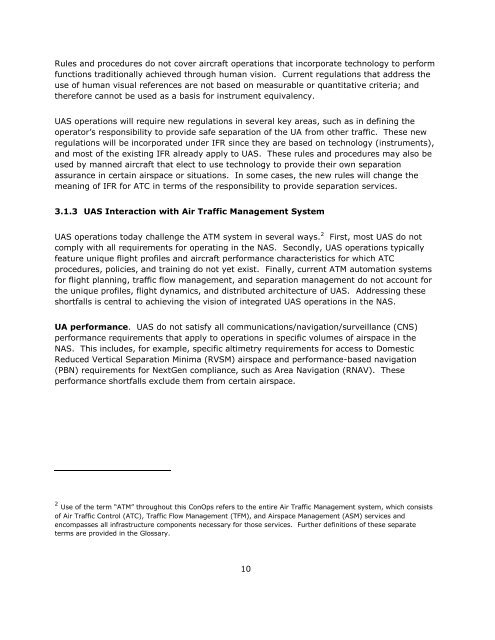FAA-UAS-Conops-Version-2-0-1
FAA-UAS-Conops-Version-2-0-1
FAA-UAS-Conops-Version-2-0-1
Create successful ePaper yourself
Turn your PDF publications into a flip-book with our unique Google optimized e-Paper software.
Rules and procedures do not cover aircraft operations that incorporate technology to perform<br />
functions traditionally achieved through human vision. Current regulations that address the<br />
use of human visual references are not based on measurable or quantitative criteria; and<br />
therefore cannot be used as a basis for instrument equivalency.<br />
<strong>UAS</strong> operations will require new regulations in several key areas, such as in defining the<br />
operator’s responsibility to provide safe separation of the UA from other traffic. These new<br />
regulations will be incorporated under IFR since they are based on technology (instruments),<br />
and most of the existing IFR already apply to <strong>UAS</strong>. These rules and procedures may also be<br />
used by manned aircraft that elect to use technology to provide their own separation<br />
assurance in certain airspace or situations. In some cases, the new rules will change the<br />
meaning of IFR for ATC in terms of the responsibility to provide separation services.<br />
3.1.3 <strong>UAS</strong> Interaction with Air Traffic Management System<br />
<strong>UAS</strong> operations today challenge the ATM system in several ways. 2 First, most <strong>UAS</strong> do not<br />
comply with all requirements for operating in the NAS. Secondly, <strong>UAS</strong> operations typically<br />
feature unique flight profiles and aircraft performance characteristics for which ATC<br />
procedures, policies, and training do not yet exist. Finally, current ATM automation systems<br />
for flight planning, traffic flow management, and separation management do not account for<br />
the unique profiles, flight dynamics, and distributed architecture of <strong>UAS</strong>. Addressing these<br />
shortfalls is central to achieving the vision of integrated <strong>UAS</strong> operations in the NAS.<br />
UA performance. <strong>UAS</strong> do not satisfy all communications/navigation/surveillance (CNS)<br />
performance requirements that apply to operations in specific volumes of airspace in the<br />
NAS. This includes, for example, specific altimetry requirements for access to Domestic<br />
Reduced Vertical Separation Minima (RVSM) airspace and performance-based navigation<br />
(PBN) requirements for NextGen compliance, such as Area Navigation (RNAV). These<br />
performance shortfalls exclude them from certain airspace.<br />
2 Use of the term “ATM” throughout this ConOps refers to the entire Air Traffic Management system, which consists<br />
of Air Traffic Control (ATC), Traffic Flow Management (TFM), and Airspace Management (ASM) services and<br />
encompasses all infrastructure components necessary for those services. Further definitions of these separate<br />
terms are provided in the Glossary.<br />
10


